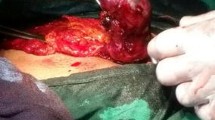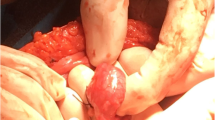Abstract
Background
Heterotopic pregnancy describes the occurrence of two pregnancies in different implantation sites simultaneously, which is rare, yet it is a challenge to diagnose such a problem due to complex clinical and laboratory findings. In the current study, we present a case of first trimester heterotopic pregnancy diagnosed by ultrasound (US) and magnetic resonance imaging (MRI) and was managed successfully.
Case presentation
A 22-year-old primigravida lady with spontaneous pregnancy was presented by increasing lower abdominal pain for 5 days with brownish vaginal discharge, nausea, and vomiting episodes. Trans-abdominal and endovaginal ultrasound was performed and revealed a viable intrauterine pregnancy of 8 weeks and 1 day, associated with a heterogeneous complex right adnexal mass. MR imaging revealed a right adnexal mass intimately anterior to the normal right ovary. Laparascopy was done; it revealed a distended right fallopian tube with pregnancy while the right ovary was not seen (impeded in the pouch of Douglas), and right salpingectomy was done. The specimen was sent for histopathology. The patient tolerated the procedure well and was then taken to the recovery room in stable condition. The histopathological report confirmed the diagnosis of ectopic pregnancy.
Conclusion
However, heterotopic is a rare condition, any pregnant woman presenting with alarming abdominal pain and adnexal abnormality; heterotopic pregnancy should be among the differential diagnosis possibilities. The patient should be thoroughly investigated using ultrasound and MRI if needed, to exclude this rare diagnosis and allow on-time proper management.
Similar content being viewed by others
Background
Heterotopic pregnancy describes the occurrence of two pregnancies in different implantation sites simultaneously, mostly manifested as intrauterine and ectopic pregnancies (ampullary in 80%). Heterotopic pregnancy is rare and estimated to occur in about 1 per 30,000 spontaneous pregnancies while a higher prevalence may occur in assisted reproduction techniques that may reach up to 1 case per 100 in some literatures. It is a challenge to diagnose such a problem due to complex clinical and laboratory findings [1,2,3,4,5,6,7,8,9].
In the current study, we present a case of first trimester heterotopic pregnancy diagnosed by ultrasound (US) and magnetic resonance imaging (MRI).
Case presentation
A 22-year-old primigravida lady with spontaneous pregnancy was presented by increasing lower abdominal pain for 5 days with brownish vaginal discharge, nausea, and vomiting episodes. Laboratory test showed a total β-HCG of 96,900 mIU/mL.
Trans-abdominal and endovaginal ultrasound were performed using the Voluson E8 device (General Electric Healthcare, Austria) with a convex 2–5 and endocavitary 5–9 MHz transducer, respectively. Grayscale ultrasound confirmed by color Doppler revealed a viable intrauterine pregnancy of 8 weeks and 1 day associated with a heterogeneous complex right adnexal mass (Fig. 1) suggestive of being a gestational sac. Pelvic fluid collection was also seen; otherwise, the ovaries displayed unremarkable ultrasound features. MRI imaging was done using Sonata Maestro Class 1.5 T device (Siemens, Erlangen, Germany). A phased-array surface coil is centered over the abdomen to cover till the symphysis pubis. Images are acquired from the level of the hepatic hilum to the symphysis pubis. The sequences included the turbo spin-echo (TSE) technique, gradient-echo (FLASH), and T1 and T2 weighting to obtain axial and coronal images. No contrast was given.
MR study revealed a right adnexal ovoid mass lesion (29 × 23 × 17 mm) intimately anterior to the normal right ovary, displaying a mixed hyper- and hypo-intense signal at T1 and T2 WI. It had a thick wall showing high T2 signal (Fig. 2).
After informed consent, the patient was transferred to the operating room where general anesthesia was applied. Laparoscopy was performed. It revealed distended right fallopian tube with pregnancy while the right ovary was not seen (impeded in the pouch of Douglas). Hemoperitoneum was noted while the left tube, left ovary, and the appendix were unremarkable. Right salpingectomy was done, and the specimen was sent to the histopathology. The patient had tolerated the procedure well.
Histopathological examination of the specimen showed a dilated congested segment of the right fallopian tube while microscopic examination revealed fragments of blood clot, decidual tissue, and chorionic villi with trophoblasts noted within the dilated fallopian tube consistent with tubal ectopic pregnancy.
Discussion
Ectopic pregnancy needs early diagnosis and management to avoid the high probability of tubal rupture. Heterotopic pregnancies can be asymptomatic in about half of the cases; otherwise, it can be presented by variable clinical presentations: mainly abdominal pain, adnexal swelling that may be associated with vaginal bleeding, or even shock due to hypovolemia. Unfortunately, the clinical findings are more frequently presented with tubal rupture [3,4,5,6,7].
While ectopic pregnancy can be early diagnosed during the screening of the serum b-HCG and endovaginal US in routine prenatal assessment, heterotopic pregnancy diagnosis can be a challenge as it may be delayed in the concurrence of intrauterine pregnancies. This can be due to the differential diagnosis between ectopic pregnancy and other situations that may be associated with normal pregnancy as hemorrhagic corpus luteum or adnexal torsion [2, 6,7,8,9].
In normal pregnancies, serum B-HCG above 1500–2000 mIU/mL should be associated with ultrasound visualized intrauterine (IU) pregnancy; however, this IU pregnancy will not necessarily exclude the chance of having a heterotopic pregnancy especially in cases receiving conception-assisted techniques.
Ultrasound picture of heterotopic pregnancy may be adnexal complex cysts or mass which can be explained by being hematosalpinx, tubal ring, or embryo. Free intra-peritoneal fluid can be seen also [4, 6,7,8,9].
In equivocal cases, MRI can be helpful; it can show an adnexal lesion that may be cystic or looks like a gestational sac. Tubal cystic dilatation with a thickened wall can also be seen, while tubal rupture will cause hematoma [9].
Heterotopic pregnancy treatment needs laparoscopy and, most often, a salpingectomy or salpingostomy. However, in hemodynamically unstable cases, laparotomy may be needed. Systemic methotrexate has no role in the management of heterotopic pregnancy due to the presence of a viable intrauterine pregnancy. Some literature described the use of local injection of potassium chloride and methotrexate, but the success rate is controversial [10,11,12,13,14].
Conclusion
However, heterotopic is a rare condition, any pregnant woman presenting with alarming abdominal pain and adnexal abnormality; heterotopic pregnancy should be among the differential diagnosis possibilities. The patient should be thoroughly investigated using ultrasound and MRI if needed, to exclude this rare diagnosis and allow on-time proper management.
Availability of data and materials
The data that support the findings of this study are available on request from the corresponding author.
Abbreviations
- US:
-
Ultrasound
- MRI:
-
Magnetic resonance imaging
- HCG:
-
Human chorionic gonadotropin
References
Fernandez H, Gervaise A (2004) Ectopic pregnancies after infertility treatment: modern diagnosis and therapeutic strategy. Hum Reprod Update 10(6):503–513
Callen PW Ultrasonography in obstetrics and gynecology. In: Levine D (ed) Ectopic Pregnancy, 5th edn. Saunders Elsevier, Philadelphia, pp 1020–1047
Xiao HM, Gong F, Mao ZH, Zhang H, Lu GX (2006) Analysis of 92 ectopic pregnancy patients after in vitro fertilization and embryo transfer. J Cent South Univ 31(4):584–587
Louis-Sylvestre C, Morice P, Chapron C, Dubuisson JB (1997) The role of laparoscopy in the diagnosis and management of heterotopic pregnancies. Hum Reprod 12(5):1100–1102
Jeon HS, Shin HJ, Kim IH, Chung DY (2012) A case of spontaneous heterotopic pregnancy presenting with heart activity of both embryos. Kor J Obstet Gynecol 55:339–342
Elito NAMD, Montenegro M, Costa Soares RDA, Camano L (2008) Unruptured ectopic pregnancy—diagnosis and treatment. State of art. Revista Brasileira de Ginecologia e Obstetricia 30(3):149–154
Dündar Ö, Tütüncü L, Müngen E, Muhcu M, Yergök YZ (2006) Heterotopic pregnancy: tubal ectopic pregnancy and monochorionic monoamniotic twin pregnancy: a case report. Perinatal J 14:96–100
Tamai K, Koyama T, Togashi K (2007) MR features of ectopic pregnancy. Eur Radiol 17(12):3236–3246
Li XH, Ouyang Y, Lu GX (2013) Value of transvaginal sonography in diagnosing heterotopic pregnancy after in-vitro fertilization with embryo transfer. Ultrasound Obstet Gynecol 41:563–569
Damario, Ectopic Pregnancy. In: Rock Jr, Jones III. Te Linde’s Operative Gynecology. 10th. Philadelphia: Lippincott Williams and Wilkins; 2011. 794-795.
Li JB, Kong LZ, Yang JB, Niu G, Fan L, Huang JZ et al (2016) Management of heterotopic pregnancy: experience from 1 tertiary medical center. Medicine. 95:e2570
Baxi A, Kaushal M, Karmalkar H, Sahu P, Kadhi P, Daval B (2010) Successful expectant management of tubal heterotopic pregnancy. J Hum Reprod Sci 3:108–110
Deka D, Bahadur A, Singh A (2012) Neena Malhotra. Successful management of heterotopic pregnancy after fetal reduction using potassium chloride and methotrexate. J Hum Reprod Sci 5:57–60
Goldstein JS, Ratts VS, Philpott T, Dahan MH (2006) Risk of surgery after use of potassium chloride for treatment of tubal heterotopic pregnancy. Obstet Gynecol 107:506–508
Acknowledgements
Not applicable
Funding
Not applicable.
Author information
Authors and Affiliations
Contributions
AT conceived the study, participated in its design and coordination, drafted the manuscript, and carried out the radiological results. AM participated in the study design and helped in drafting the manuscript and radiological results. EM participated in the study design and helped in drafting the manuscript and radiological results. AA participated in the study design and helped in drafting the manuscript and radiological results. All authors read and approved the final manuscript.
Corresponding author
Ethics declarations
Ethics approval and consent to participate
This study was approved by the ethical committee of the institution as well as informed written consent from the patient included in this study was taken.
Consent for publication
All authors read and approved the final manuscript.
The patient included in this research gave written informed consent to publish the data contained within this study.
Competing interests
The authors declare that they have no competing interests.
Additional information
Publisher’s Note
Springer Nature remains neutral with regard to jurisdictional claims in published maps and institutional affiliations.
Rights and permissions
Open Access This article is licensed under a Creative Commons Attribution 4.0 International License, which permits use, sharing, adaptation, distribution and reproduction in any medium or format, as long as you give appropriate credit to the original author(s) and the source, provide a link to the Creative Commons licence, and indicate if changes were made. The images or other third party material in this article are included in the article's Creative Commons licence, unless indicated otherwise in a credit line to the material. If material is not included in the article's Creative Commons licence and your intended use is not permitted by statutory regulation or exceeds the permitted use, you will need to obtain permission directly from the copyright holder. To view a copy of this licence, visit http://creativecommons.org/licenses/by/4.0/.
About this article
Cite this article
Ali, T., Tawab, M.A., ElHariri, M.A.G. et al. Heterotopic pregnancy: a case report. Egypt J Radiol Nucl Med 51, 214 (2020). https://doi.org/10.1186/s43055-020-00325-9
Received:
Accepted:
Published:
DOI: https://doi.org/10.1186/s43055-020-00325-9






